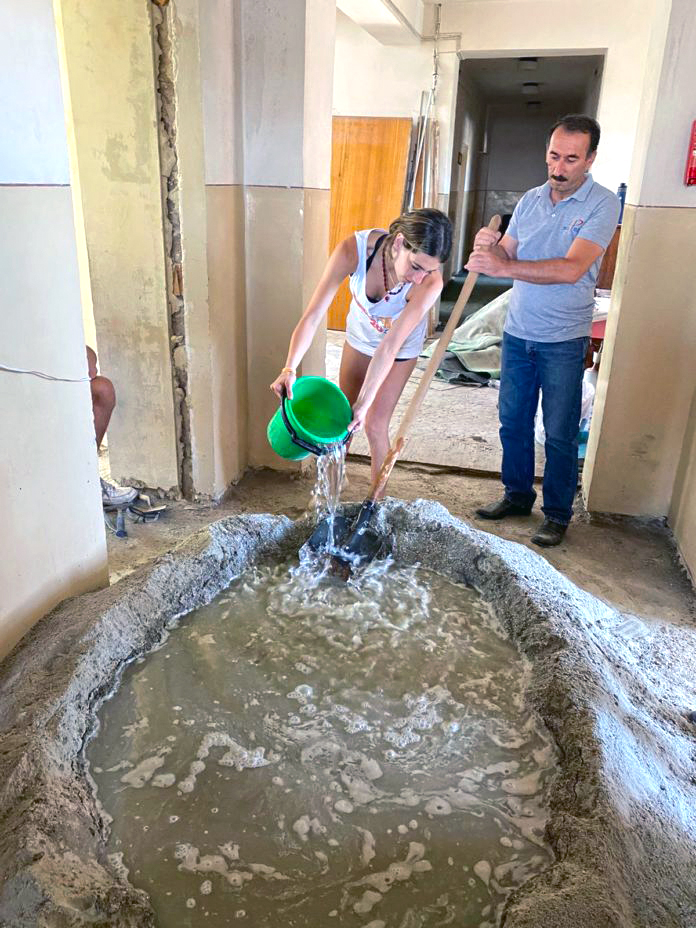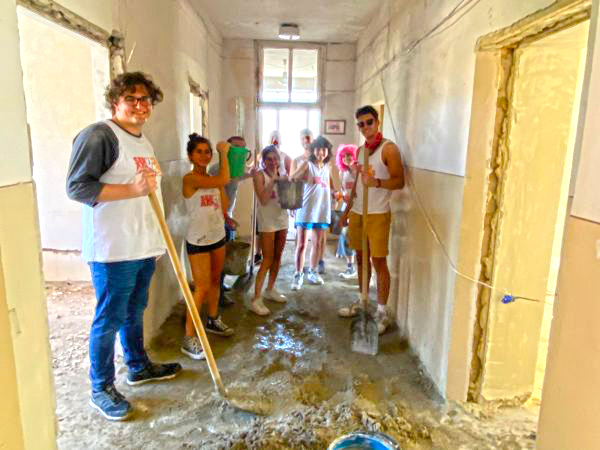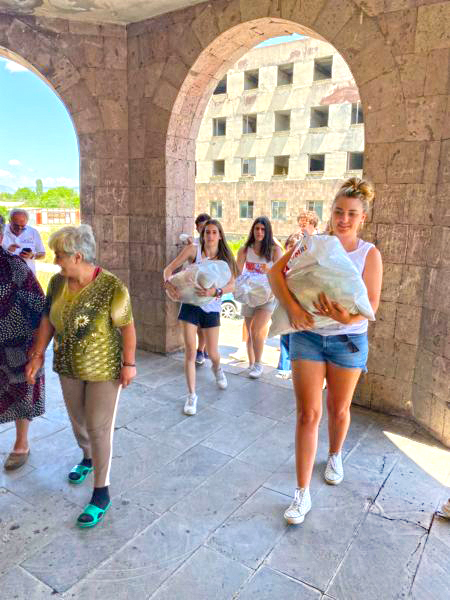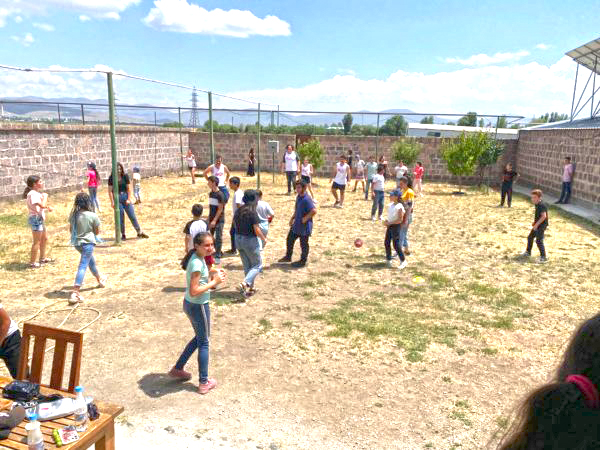
Mixing cement in Talin for the music school
Volunteers Help Build Armenia’s Future
by Muriel Mirak-Weissbach
YEREVAN, AUGUST 24, 2022 — “The construction related projects were sometimes laborious but always very rewarding, with apparent progress offering a consistent boost in moral. The work with the children was also fascinating, as we got a look into the educational and cultural differences in the next generation of Armenians, and gained some perspective on our own upbringings.” This is how Justin Leach described two aspects of the work he engaged in this summer, during his vacation from college. He and his cousin Christina Kew were two of a group of eight youngsters from America who took part in the Paros Foundation’s SERVICE Armenia program, spending three weeks in the country that their ancestor, survivors of the Genocide, never had the opportunity to visit. Their great-grandparents, Artemis and John Mirak, would have been thrilled to learn of their experience. Their great-aunt (who is writing these lines) certainly was excited to talk to them about it.
Justin and Christina were in Armenia from July 3-24, serving as volunteers on projects to physically renovate social facilities, assist in educational and recreational activities with local youngsters, and visit religious and historical sites to learn more about their own cultural heritage. The Paros Foundation provides the projects, logistics, and experienced staff to guide them, and the volunteers do the work.

Young volunteers
Tearing Down and Building Up
This was no token gesture; it was hard work. The first deployment was on a construction site. Talin, which is located in the Aragatsotn Region, is a town with about 5,400 inhabitants, and, like so many small communities, does have a music school. However, the school was in terrible shape when the Paros Foundation took on the task of renovation. The 15 teachers there in 2016 were providing instruction for 120 students, but without adequate facilities for practicing, not to mention performing; the health and safety standards were poor, utterly unconducive to motivating students. Paros decided to embark on a project, in cooperation with the town, to provide it with a modern school where youngsters could study music, both folk and classical, and with appropriate instruments. Concretely this meant rebuilding the existing structure, totally renovating two floors, building a concert hall, and providing modern rooms and sanitary facilities.,
“We were there for 3 to 4 days,” Leach said, “helping with the construction project. They took us up to the third floor, which had been renovated, and then we went to the floor below, which needed it. There was dust everywhere, the floors were coming apart. Our task was to tear out the wood of the floors, using hammers, to chip away at the tar that was like glue; this way we could tear out the old floor boards and make way for a new floor.”
That was just the beginning. “On Day 2,” he continued, “we scraped paint off the walls, then primed them for a new coat of paint.” Construction work is demanding and requires teamwork. In fact, there was a clear division of labor. “The boys carried sand and bags of cement up, in assembly-line fashion, and the girls brought up the water to make the concrete. And then they had the task of priming the walls.” It required not only muscle power but also time. “We spent a couple of days mixing sand and cement to make concrete,” he explained. “Everything was done manually. We had to shovel and churn, filling up buckets, making concrete. It was arduous, pretty grueling.”
The days were long. They would get up early, be on the bus by 8 o’clock, ride for an hour to the construction site, then work from 10 to 4:00.” No lunch break? “Sure, we had peaches and sandwiches,” he said.

Carrying bags of food in Gyumri
Gyumri Three Decades Later
In 1988, Armenia’s second largest city, Gyumri, was nearly obliterated by an earthquake which devastated large parts of the region, leaving over 100,000 homeless. Many moved into domiks, container-like shelters, and what was supposed to be “temporary” for many became permanent. Jobs were nowhere to be found, poverty spread for years. Children were among the most vulnerable, lacking adequate housing, nutrition, sanitation, and education.
In 2015, the Paros Foundation launched a project to begin to address their needs, called the Debi Arach Children’s Center. The name in Armenian means “moving forward.” The approach is holistic, aiming at helping children physically, psychologically, and intellectually. This means providing adequate meals on a daily basis, as well as bathing facilities, psychological counselling, and tutoring in all the subjects they take at school. The Center started with 185 children, and has been expanding its efforts to offer vocational training, including computer skills.
Debi Arach was the next assignment for Leach, Kew, and their co-volunteers. Before leaving Yerevan for Gyumri, they prepared back packs for the youngsters. As Leach explained, they filled about 80 of them, with basic supplies for school: pencils, rulers and notebooks. When they arrived at the center, they distributed the back packs, then “had a chance to engage with the kids, playing soccer and working in arts and crafts.”
Confrontation with the conditions Gyumri residents have had to endure since the earthquake was a shock for both. “The poverty is still rampant,” Leach said. “We filled up trash bags with food and delivered them to needy families there, most of them living in shacks, domiks.” “It was a difficult situation,” Kew added. “Here were these older women, saying they needed food — what could you do?”
Leach said he had never experienced anything like that before. “It was pretty intense. It was fulfilling on the one hand, but somehow, there was also a feeling of paternalism, it somehow didn’t ‘feel right.’ It seemed ‘not right.’ I gave one woman a bag of food, and was to follow the woman into a room, if you can call it that — bricks piled up on top of each other for walls. She took my hand and thanked me, but since I couldn’t speak Armenian, I couldn’t reply. I knew what I was signing up for, but here was a woman four times my age, and I thought, I have no expertise to be doing this.”

Volunteers playing soccer with children in Gyumri
Breaking the Language Barrier
Language, in fact, was a barrier. How did they deal with it? “We had Christina!” was Leach’s immediate response. Kew is a graduate of St. Stephen’s Armenian Elementary School in Watertown, Mass., which offers bilingual education. In preparation for this trip, she had taken a refresher course, and, as one of three Armenian speakers in the group, together with Marina, their guide, she functioned as a translator. “It was a bit difficult with the bus driver, and the project managers,” Leach noted, “and we learned what it means to face a language barrier.”
They encountered an even more complex form of language barrier back in Yerevan. One day they accompanied a group of children with special needs on a visit to an amusement park near Victory Park. “This was a real challenge,” Leach said, “the most difficult situation as far as language was concerned; we couldn’t speak Armenian and had to rely on hand language, gestures, trying to communicate with children who already had difficulties, many of them non-verbal and distracted.” This compounded the problem of not knowing the language, and “led to an unparalleled necessity for sign language. In order to communicate at all, “to be able to ‘speak on their level,’” as Justin put it, “all we had was eye contact and moving our hands. We managed somehow, and actually succeeded in creating a bond of sorts.”
On another fun day they took children from Nork Marash, an orphanage outside Yerevan for a visit to the zoo. “The kids loved it,” Kew said. “They ranged in age from 5 to 8, and when they saw the elephants and the camels and lions, they loved it!”
Revisiting the Past
The program was packed with activities on projects designed to build a better future for Armenia and its people, providing better living standards for the aged as well as the children, the healthy as well as the disadvantaged. But it was also an educational experience for the volunteers, who had the opportunity to visit historical, religious, and cultural sites, and thereby learn about their own Armenian past.
Both Leach and Kew had visited before. Leach had been there two years ago with his family, and Kew had also visited, once a decade ago with her graduating class from St. Stephen’s, so both of them had seen the ancient sites, churches, and monasteries, Garni, Echmiadzin, and many others. On this trip, they might have seen “as many as 30 churches.”
Leach reflected on the personal impact. “It was an interesting perspective for someone like myself who has not been raised in the Armenian church; to see these religious monuments, some of them over a thousand years old, all expressing one strain of spirituality, a very humbling experience.” He is a sophomore at Emory College, studying philosophy, politics and law, as well as sociology. “I’m majoring in philosophy,” he said, “thinking of course about theology, and you know, I had the notion, ‘well I have my thoughts on everything,’ but then to be confronted by these ancient sites, 1000 years old, it’s striking in a different way.”
Kew is entering her junior year at Endicott with a major in hospitality. On this trip, she had traveled to Armenia two weeks earlier, with her sister Alex and her mother, Julia Kew, who were with the Armenian Tree Project. In addition, she toured another week on her own. “The first two weeks I toured everywhere,” she said, “then with the group toured again. For me what I took away was the sense, here are different people coming together, and the question was, how to work as a team, how to help. It wasn’t easy, considering the age group, with some kids only 15 others, 20-21, our age, but it worked out.”
Yes,” Justin agreed, “working with people in different age groups is educational, powerful. You go to Gyumri, see a lot of poverty, which is shocking poverty, but alien, somehow, you think, ‘it’s a different world’, different from America. But at the schools, with kids of a similar socio-economic status, it was a recognizable environment, we played soccer and football, and they all had phones. There were fifth-graders with phones, taking pictures, using Instagram. At the same time, there we were, giving them back packs with school supplies. As kids, you adapt, you blend in, being with them; even their clothes were familiar, ordinary, so I felt it was like people I could recognize, although they had different circumstances.”
To sum it up, Leach commented, “Though Christina and I had already visited some of these sites, including the genocide memorial and museum, the historical significance was not lost on us, and helped to put the service we were doing into perspective. The pairing of these activities (touring and service) worked nicely to contextualize the import of the country’s future success with the consequences of its history.”
(For more information, see: https://parosfoundation.org/service-armenia/)